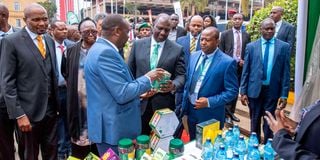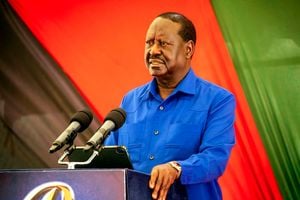Kenya’s Africa exports cross Sh200bn mark

President William Ruto flags off value-added tea for export to Accra, Ghana during the African Continent Free Trade Area Guided Trade Initiative at KICC, Nairobi on November 5, 2022.
Kenya’s earnings from exports to African countries for the half-year period have crossed the Sh200 billion mark for the first time, giving a boost to President William Ruto’s push for increased intra-African trade.
Kenyan traders earned an estimated Sh202.40 billion from goods sold on the continent in the first six months of the year, latest official statistics show, a 20.30 per cent growth over a similar period last year.
Africa accounted for a record-high 42.23 per cent of the country’s Sh479.29 billion total value exports in the review period, according to provisional trade data collated by the Central Bank of Kenya.
The share was higher than 38.84 percent, or Sh168.24 billion, in a similar period last year when total inflows from export of goods amounted to Sh433.15 billion.
The uptick has come at a time President William Ruto is championing the removal of trade barriers amongst African countries to ease the movement of goods, services and labour through integration of regional trading blocs.
The integration is aimed at creating the world’s largest single market of about 1.4 billion people with an estimated economic output of more than $3 trillion (Sh429 trillion where $1 is equivalent to Sh143) under the ambitious African Continental Free Trade Agreement (AfCFTA).
Kenya is amongst African countries with highest share of intra-Africa trade. For example, Africa accounted for 19.14 percent, or Sh328.70 billion, of Kenya’s Sh1.72 trillion total trade value in the January-June 2023 period.
That is increased from 17.75 percent, or Sh298.25 billion, of Sh1.68 trillion total merchandise trade value in the corresponding period the year before.
Africa’s under-developed transport networks have been blamed for raising the cost of goods and services by as much as 40 per cent, rendering intra-African trade uncompetitive compared with trade with developed continents such as Europe.
For example, the first consignment of Kenya’s value-added tea to Ghana which left the country last October reached Port of Tema in February this year, highlighting the infrastructural, security and tariff hurdles hampering intra-African trade.
“This is why we must take such barriers as weak transport and logistics capacity, customs-related delays, rules of origin, import bans and export restrictions, quotas and levies, technical barriers, import permits and licenses, very seriously because they ultimately reverse all the depths we try to make towards a free trade area,” Dr Ruto told Africa’s trade ministries’ officials and private sector leaders attending an AfCFTA forum in Nairobi on May 29. “They may look small, incremental but their sum total amounts to a reversal of what we are trying to achieve.”
The data shows the growth in exports to Africa were largely lifted by Uganda where traders trucked goods worth Sh62.49 billion in the six-month period through June, a 40.23 per cent jump over Sh44.56 billion a year earlier. The land-locked country largely buys fuel, vegetable oil, pharmaceuticals, iron and steel as well as paper and paperboard from Kenya.
The value of goods sold to Tanzania, on the other hand, increased 10.07 per cent to Sh29.35 billion, Rwanda’s rose 8.71 percent to Sh20.00 billion, while earnings from exports to Egypt fell a modest 2.80 percent to Sh14.10 billion.
The CBK data further shows that exports to small destinations on the continent went up 6.91 per cent to Sh36.50 billion.
The trade diplomacy adopted by President Ruto is a continuation of a policy initiated by his predecessor, Mr Uhuru Kenyatta, who on June 8, 2018 led the country in presenting documents ratifying the proposed Comesa-East African Community- Southern African Development Community tripartite free trade area to the Comesa secretariat.
Upon the attainment of the tripartite deal, which will create a market of 27 countries, Nairobi plans to lead the way in pushing for more integration with other regional blocs including the Economic Community of West African States and the Maghreb (which covers Algeria, Libya, Mauritania, Morocco and Tunisia, but excludes Egypt).
This is also entrenched in Kenya’s Integrated National Exports Development and Promotion Strategy, launched in July 2018, which has listed Africa, alongside China and India, as having the biggest potential for growth of exports.





